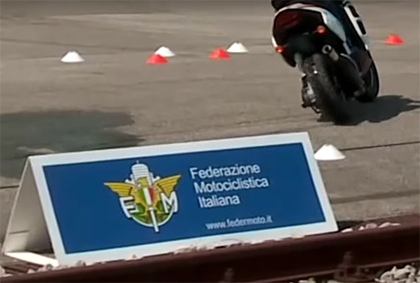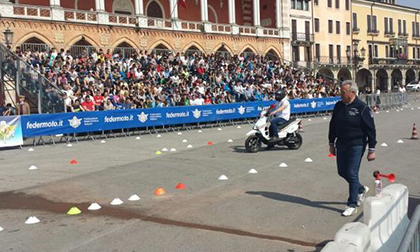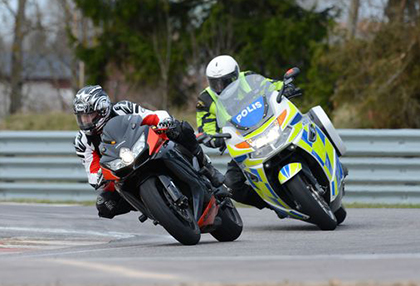 We have followed the Fédération Internationale de Motocyclisme (FIM) Annual Road Safety Awards ever since we brought a version of an original road safety programme to Northern Ireland in our previous life as Right To Ride.
We have followed the Fédération Internationale de Motocyclisme (FIM) Annual Road Safety Awards ever since we brought a version of an original road safety programme to Northern Ireland in our previous life as Right To Ride.
That award was for the Ambulance Motorcycle Club of the UK CRASH Card www.crashcard.co.uk which is now available in several European countries and the United States. This received the FIM Road Safety Award in 2012.
This year, marking the seventh year of the FIM Roa Safety award, was originally instituted as part of the FIM’s contribution to the United Nations Decade of Action for Road Safety and can be conferred on an individual, a club, a national federation, a governmental organisation, a non-governmental organisation, or a commercial entity.
Naturally the award is focussed on improving road safety for riders of powered two wheelers – motorcycles, scooters and mopeds and this year saw three nominations from SKIDBIKE – Swedish Motorcyclists Association (SMC) – Federazione Motociclistica Italiana (FMI).

The winner was announced at the FIM Gala Ceremony which was hosted by Germany in Berlin in front of six hundred invited guests. This was as part of the evenings awards for the exploits of the World’s best motorcycle and their achievements within two-wheel sport.
The FIM Road Safety Award was one of four special presentations on the night which included the FIM Fair Play Trophy presented to Laia Sanz; the FIM Environmental Award, which was won by the Circuit de Barcelona-Catalunya; the FIM Woman in Motorcycling Award was announced as the AMA Get Women Riding Campaign – USA.
The 2016 FIM Road Safety Award went to the Federazione Motociclistica Italiana (FMI) for its programme of road safety training.
President Paolo Sesti of the FMI said, “I am delighted that the International Federation has decided to reward the IMF for its commitment to road safety. Many years in Italy working in this field alongside the institutions, the Ministry of Transport and the Ministry of Education to achieve the greatest possible number of students and adults and provide input that is useful to stimulate their good behavior on the road. Being able to share this experience at the international level through the FIM is to have the ability to continually improve our activities.”
Receiving the award at the FIM Gala, Francesca Marozza, Coordinator of the Department of Road Education of the FMI stressed that, “this award is dedicated to the daily commitment of all our trainers who combine a passion for the bike to a great preparation in the education sector and road safety.”
Federazione Motociclistica Italiana (FMI)
 The FMI is famous for being one of the most successful organisations in the history of motorcycle sports. What is not so well known outside Italy is the rider training programme.
The FMI is famous for being one of the most successful organisations in the history of motorcycle sports. What is not so well known outside Italy is the rider training programme.
Italy is a country where the use of powered two wheelers (mopeds, scooters and motorcycles) is a major feature of everyday travel. For example in the greater Rome area over 700,000 PTWs are in use.
With ancient cities such as Rome there is as much “city” under the ground as above it. This makes extending public transport in the form of metro trains difficult. Additionally the favourable climate makes using a PTW an attractive option.
FMI training covers a wide range of activity. – In schools, in partnership with the Ministry of Education. This work has now been extended to younger children as well to cover general road safety and cycling.
During the year FMI also organises special “road shows” in partnership with the police, fire service and ambulances service. At these events students from several schools will be brought together. The emergency services demonstrate the reality of road traffic collisions in a dramatic way.
FMI has also taken on the task of training government officials who administer the riding test.
The Other Nominations
SKIDBIKE
 Is a device designed for training new riders. The instructor has a remote control device and the degree of lean can be restricted.
Is a device designed for training new riders. The instructor has a remote control device and the degree of lean can be restricted.
The instructor can also use the remote control to cut the engine off at any point. The main feature is the platform which can be adjusted to limit the contact between the tyres and the surface of the training area. – The same system has been in use with SKIDCAR for many years and I had experience of training with SKIDCAR during my police service. The wings make it safe for the rider to practice. The manufacturers also point out that the machine can be used for riders to practice skills in emergency braking.
There has been much debate and research in recent years concerning the value of training drivers on skid pans or with SKIDCAR. The emerging consensus is that this type of instruction is of little value. Additionally more cars today are equipped with electronic stability control.
SKIDBIKE is however a new device and motorcycling is not the same as driving a car. Research shows that the average rider can apply only 56% of the available braking power in an emergency (Ecker & Wassermann, 2001). – That is the average riders, collision investigators often find that in an emergency some riders do not brake at all.
Therefore a device that allows for practising emergency braking safely will be valuable.
Swedish Motorcyclists Central Organisation (SMC)
 The pattern of motorcycle use in Sweden is totally different to Italy. The number of riders is small (around 300,000) and motorcycling is mainly a leisure activity. – Although of course some riders do travel to and from work when the weather allows. Almost all motorcycling (on the roads) ceases in winter.
The pattern of motorcycle use in Sweden is totally different to Italy. The number of riders is small (around 300,000) and motorcycling is mainly a leisure activity. – Although of course some riders do travel to and from work when the weather allows. Almost all motorcycling (on the roads) ceases in winter.
For many years SMC ran spring time courses so that riders could get some practice after the winter.
This has now developed to SMC School which runs through three seasons and involves hundreds of courses.
For 2016-2017 SMC has committed a budget of up to one million euro to give a voucher for a free course to every person in Sweden who buys a new motorcycle.
SMC also uses it safety training as a vehicle to “guide” riders who are interested in fast riding into the sport and not to do this on the road. An amateur racing series suitable for older riders has been developed in partnership with SVEMO. SMC Sport is now the largest racing club in Sweden.
SMC also works with the Swedish police and courses for police officers have also been run.
Past Winners
2010: Greig Craft and the AIP Foundation for low cost motorcycle safety helmets in middle and low income countries. www.aip-foundation.org
2011: Andrés Perez Rubio, former motorcycle racing champion, for his work for road safety, in particular barrier safety on the streets. FIM Road Safety Award 2011 FOM Road Safety Award
2012: Ian Burrell MBE and the Ambulance Motorcycle Club of the UK for the helmet medical card (now more than a million distributed worldwide) CRASH Card is a programme in which motorcyclists place a card inside their crash helmet as a medic alert. The details which the rider has written on the card provide vital information for attending ambulance crews if the motorcyclist is injured in an road traffic collision. Saving valuable time and helping treatment especially if the rider is either unconscious or unable to communicate. www.crashcard.co.uk
2013: The United Kingdom Department for Transport for the SHARP star rating system of independent testing of helmets – modelled on the star rating system for cars. sharp.dft.gov.uk
2014: The KNMV (Royal Dutch Motorcycle Federation) for their work in developing scientifically proven risk awareness training for road riders. VRO Risico KNMV – VRO-Risico
2015: Mr Tony Rich a patrol officer in the AA for his concept for a cycle and motorcycle “awareness” programme directed at drivers. This has become an international campaign promoted by FIA Region One. Think Bikes Campaign Think Bikes Campaign
Sources: Fédération Internationale de Motocyclisme (FIM) – Federazione Motociclistica Italiana (FMI)


Leave a Reply